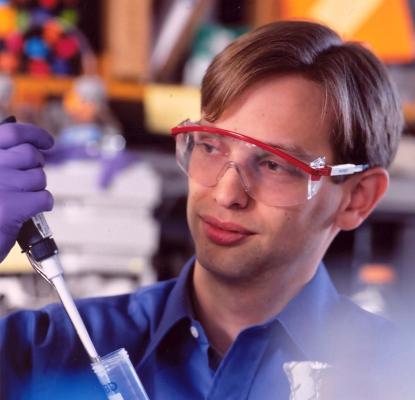David Berry
“What I appreciate most about science and research is that although you don’t aid people on a day-to-day basis as physicians do, you have the potential to impact society as a whole,” says David Berry. In 2005, Berry was named the $30,000 Lemelson-MIT Student Prize winner for his innovations in both stroke and cancer treatments.
Hailing from Mt. Kisco, New York, Berry didn’t always know he’d become an inventor. Berry says he was a kid who liked to tinker, build, disassemble, and try to put things back together again. Sometimes he succeeded in his endeavors, though he admits he probably failed more often. “I was very big on taking parts from the LEGO‘ set and the parts from other toys and trying to make something faster or cooler.” His parents encouraged his experiments from a young age.
Berry received both his SB in brain and cognitive sciences (2000) and PhD in biological engineering (2005) from MIT and MD from the Harvard-MIT Health Sciences and Technology program (2006). While at MIT, Berry began studying heparin, a common anticoagulant, and a protein called fibroblast growth factor (FGF2), which is involved in the formation of new blood vessels. Under the advisory of MIT Professor Ram Sasisekharan, Berry and his colleagues developed the new protein, dimeric FGF2 (dFGF2), to synthesize a more effective drug for stroke victims. If given within 24 hours of a stroke, dFGF2 can limit the amount of brain tissue that is damaged. If given after 24 hours, it can substantially improve the patient’s rate of functional recovery, which current treatment does not. DFGF2 has gone through pre-clinical trials.
“I don’t like thinking about things as just a simple project. I like thinking about them as more of a global problem,” notes Berry, who also applied his research with heparin and dFGF2 to cancer treatment. He discovered that a heparin-polymer compound delivered to the body could attack cancer cells, while not disrupting surrounding healthy cells. By leaving healthy tissue alone, the drug can attack the tumor without the familiar side effects of chemotherapy.
In further pursuits to improve cancer treatment, Berry experimented with his creation of a heparin surface coating that binds to and removes cancer cells that may have been missed during surgery.
In collaboration with colleague Richard Reznick, Berry has also explored biohydrogen production, or using things that exist in nature to produce hydrogen, for a potential solution to the energy problem. Their research focused on developing an inexpensive way to harness hydrogen from bacteria.
Berry’s ultimate career goal is to help improve the quality of peoples’ lives. If you really want to do something to impact people and bring it into society, you need to bring it out of an insular environment. Entrepreneurship and business aren’t a completely different interest, it’s more of a way one can take successes in an academic environment/laboratory environment, and bring them into the real world. It’s a way to affect change.”
Berry joined Flagship Ventures in 2005 where he continues to focus on innovating, entrepreneurship and investing in life sciences and sustainability. Berry was elected a 2014 Young Global Leader by the World Economic Forum. Previously, he was named one of the top 35 innovators under the age of 35 by Technology Review in 2007. He was also selected by the U.S. State Department as 1 of 12 Innovators Helping to Reshape Reality.


